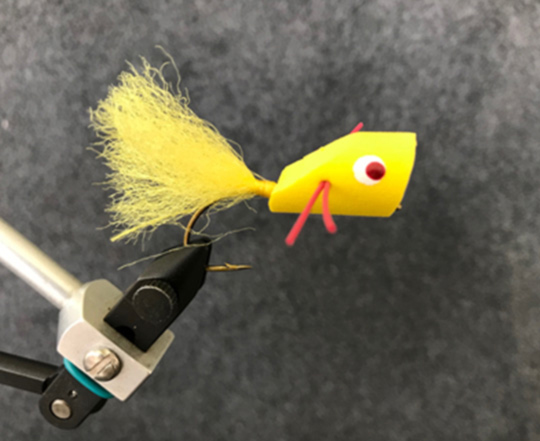I learned to fly fish while targeting smallmouth bass in the upper Potomac River. I caught most of them on a store-bought size-four Gaines Bass King popper made with a cork body, flashy enamel paint, rubber legs, and feathers for the tail. The distinguishing feature of a popper is its broad face at the hook’s eye. They work just like topwater plugs, with the Rebel Lures Pop-R coming to mind. The wide face at the eye of the hook allows you to chug it through the water as you retrieve it, creating a disturbance on the surface that attracts fish. But a popper’s design also creates wind-resistance when you try to cast a large one on a fly rod. Most fly anglers use six- and seven-weight rods to cast poppers meant for bass and stripers. Four- and five-weight rods are more appropriate for smaller panfish poppers.

I no longer use commercial poppers, as foam poppers are easy to make. Mine are not works of art or as pretty as commercially available poppers — but fish don’t mind the difference. The action of a popper and how you modify that action by varying your retrieves makes a greater impact on the willingness of fish to bite than its appearance does.
White, blue, yellow, green, black, and red poppers have all worked for me. Color selection depends on what strikes my fancy when I open my fly box, and the fish will tell me if I’ve made the right choice.
The best poppers have three important aspects concerning their hooks. The first is that the hook should have a wide gap. Fish inhale a popper when they attack. When they discover that it’s not food, they’ll try to spit it out. They are less likely to succeed in that act if the hook has a wide gap. Second, the hook point should not be shielded directly under the body of the popper. You want the point to be positioned well behind the popper body to aid in hookups. Finally, and this goes for all flies, the hook should be sharp and kept that way with frequent attention from your sharpening stone during an outing.
Excerpted from: “Fly by the Seat of Your Kayak — A Guide to Simplified Kayak Flyfishing in Tidal Creeks and Freshwater Ponds” by Mark Bange. This new book is available on Amazon for $17.98 or via email to the author: [email protected].